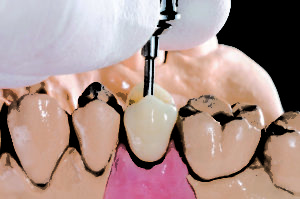In an industry that offers so many options and emerging products restoratively, many of us have never heard of one of the new and extremely useful phenomenons: the Screwmentable. What is a Screwmentable? It’s a restoration consisting of an abutment, a crown and a screw. To many, that doesn’t sound any different from a screw-retained restoration, and it shouldn’t. But here’s where it differs. With a Screwmentable, we at the Lab pre-cement the crown to the abutment creating a one-piece restoration. All that is left to be done is to screw the abutment (through the access hole in the crown) down and then place composite over the screw access hole to hide the area. Voila, we have the Screwmentable!
Here’s why this solution should be considered. First of all, it is very cost effective as it not only allows the use of stock or Ti base abutments, but it saves chair time as it arrives to the practice already cemented into one piece, leaving a clean and smooth surface that will be sub gingival. The Screwmentable also alleviates the worry about cement entrapment as the lab pieces the crown and the abutment together, and as such, a spinoff is that it therefore helps prevent peri implantitis that excess cement may cause. Finally, moving forward, there is the ease of future access and retreiveability should the screw become loose or the cement erode. In both cases, unlike with a cement-retained restoration, there is no need to try and find the mesostructure of the abutment below because the screw access hole is available. All that would need to be done is one of two options. Drill out the composite cover and either tighten the screw, or remove the Screwmentable and re-cement chairside, or in more complicated situations, return to the lab for cementation.
Screwmentables can be used for a wide variety of restorations including Full Contour and Layered Zirconia, PFM’s and e.Max. Of note, as with all implant procedures, we would recommend that the master model be saved at the practice in case of potential micro movements or any unforeseen complications arising down the line. Should you have any question, concerns or comments please feel free to call or email us at Shaw Laboratories. 416-977-0700 / info-toronto@shawlab















